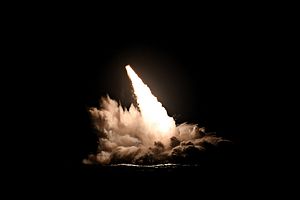By Ankit Panda
 On Tuesday, John Rood, the U.S. under secretary of defense for policy, confirmed that a new low-yield nuclear warhead had been fielded by the U.S. Navy on board certain Ohio-class ballistic missile submarines.
On Tuesday, John Rood, the U.S. under secretary of defense for policy, confirmed that a new low-yield nuclear warhead had been fielded by the U.S. Navy on board certain Ohio-class ballistic missile submarines.
“The U.S. Navy has fielded the W76-2 low-yield submarine-launched ballistic missile (SLBM) warhead,” Rood said in a statement. The W76-2 is a new modification of the W76-1 that was called for by the Trump administration’s Nuclear Posture Review, which was released two years prior, in February 2018.
“In the 2018 Nuclear Posture Review, the department identified the requirement to ‘modify a small number of submarine-launched ballistic missile warheads’ to address the conclusion that potential adversaries, like Russia, believe that employment of low-yield nuclear weapons will give them an advantage over the United States and its allies and partners,” Rood said in his statement.
“This supplemental capability strengthens deterrence and provides the United States a prompt, more survivable low-yield strategic weapon; supports our commitment to extended deterrence; and demonstrates to potential adversaries that there is no advantage to limited nuclear employment because the United States can credibly and decisively respond to any threat scenario,” Rood continued.
The W76-2 will add a low-yield option on the United States’ main undersea nuclear delivery vehicle, the UGM-133A Trident II D5 SLBM. Until the introduction of the W76-2, American SLBMs carried either the W76-1, a 90 kiloton nuclear warhead, or the W88, a 455 kiloton nuclear warhead. The new W76-2 is thought to be a modification of the two-stage thermonuclear W76-1 that only detonates the weapon’s primary stage, resulting in a detonation that may be in the realm of 5 to 10 kilotons.
Critics of the new low-yield option on American SLBMs have expressed concerns about the inability for adversaries to discriminate an incoming low-yield warhead from a higher-yield warhead until a detonation were to take place.
The 2018 Nuclear Posture Review called for the weapon to “help counter any mistaken perception of an exploitable ‘gap’ in U.S. regional deterrence capabilities.” Although other low-yield options exist in the U.S. arsenal, including the air-launched cruise missile (ALCM) and the B61 gravity bomb, neither is as promptly delivered as the low-yield D5, which can reach its target in tens of minutes at the longest.
The 2018 Nuclear Posture Review called for the development and fielding of two new nuclear capabilities, one of which was the low-yield warhead for the Trident SLBM. The other, a sea-launched cruise missile, has yet to be developed.
No comments:
Post a Comment